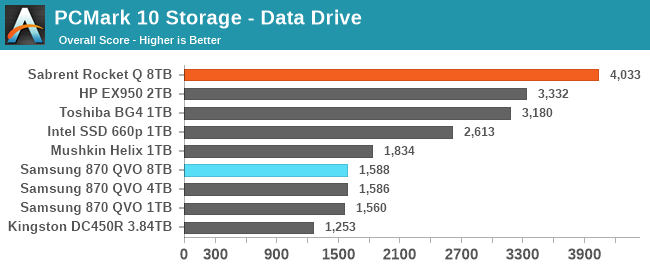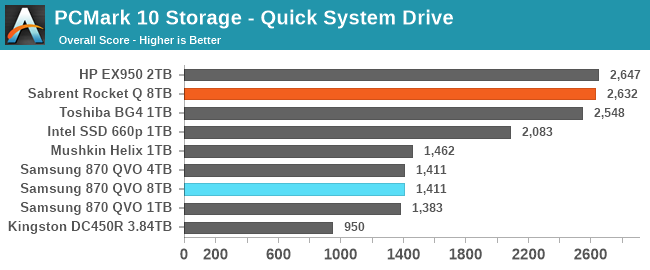QLC Goes To 8TB: Samsung 870 QVO and Sabrent Rocket Q 8TB SSDs Reviewed
by Billy Tallis on December 4, 2020 8:00 AM ESTPCMark 10 Storage Benchmarks
At the end of 2019, UL released a major update to their popular PCMark 10 benchmark suite, adding storage performance tests that had been conspicuously absent for over two years. These new storage benchmarks are similar to our AnandTech Storage Bench (ATSB) tests in that they are composed of traces of real-world IO patterns that are replayed onto the drive under test. We're incorporating these into our new SSD test suite, and including our first batch of results here.
PCMark 10 provides four different storage benchmarks. The Full System Drive, Quick System Drive and Data Drive benchmarks cover similar territory to our ATSB Heavy and Light tests, and all three together take about as long to run as the ATSB Heavy and Light tests combined. The Drive Performance Consistency Test is clearly meant to one-up The Destroyer and also measure the worst-case performance of a drive that is completely full. Due to time constraints, we are not yet attempting to add the Drive Performance Consistency Test to our usual test suite.
| PCMark 10 Storage Tests | ||
| Test Name | Data Written | |
| Data Drive | 15 GB | |
| Quick System Drive | 23 GB | |
| Full System Drive | 204 GB | |
| Drive Performance Consistency | 23 TB + 3x drive capacity | |
The primary subscores for the PCMark 10 Storage benchmarks are average bandwidth and average latency for read and write IOs. These are combined into an overall score by computing the geometric mean of the bandwidth score and the reciprocal of the latency score. PCMark 10 also records more detailed statistics, but we'll dig into those in a later review. These PCMark 10 Storage test runs were conducted on our Coffee Lake testbed:
| AnandTech Coffee Lake SSD Testbed | |
| CPU | Intel Core i7-8700K |
| Motherboard | Gigabyte Aorus H370 Gaming 3 WiFi |
| Chipset | Intel H370 |
| Memory | 2x 8GB Kingston DDR4-2666 |
| Case | In Win C583 |
| Power Supply | Cooler Master G550M |
| OS | Windows 10 64-bit, version 2004 |
Data Drive Benchmark
The Data Drive Benchmark is intended to represent usage a secondary or portable drive may be subject to. This test simulates copying around files, but does not simulate the IO associated with launching and running applications from a drive.
 |
|||||||||
| Overall Score | Average Bandwidth | Average Latency | |||||||
Starting off, the 8TB Sabrent Rocket Q leads the field thanks to its massive and fast SLC cache; it clearly outperforms even the decently high-end 2TB TLC-based HP EX920. The several capacities of the Samsung 870 QVO all performa about the same: less than half the speed of the faster NVMe drives, and slower than the slowest entry-level NVMe drives. The enterprise SATA drive with no SLC caching comes in last place.
Quick System Drive Benchmark
The Quick System Drive Benchmark is a subset of the Full System Drive Benchmark, running only 6 out of the 23 sub-tests from the Full test.
 |
|||||||||
| Overall Score | Average Bandwidth | Average Latency | |||||||
Moving on to the Quick test, the Sabrent Rocket Q no longer stands out ahead of the other NVMe drives, but still offers decent performance. The performance gap between the NVMe drives and the Samsung 870 QVO drives has narrowed slightly, but is still almost a factor of two.
Full System Drive Benchmark
The Full System Drive Benchmark covers a broad range of everyday tasks: booting Windows and starting applications and games, using Office and Adobe applications, and file management. The "Full" in the name does not mean that each drive is filled or that the entire capacity of the drive is tested. Rather, it only indicates that all of the PCMark 10 Storage sub-tests are included in this test.
 |
|||||||||
| Overall Score | Average Bandwidth | Average Latency | |||||||
The Full test starts to bring the downsides of QLC NAND into focus. The Sabrent Rocket Q is now the slowest of the NVMe drives, only moderately faster than the 8TB Samsung 870 QVO. The 1TB 870 QVO is also falling behind the larger and faster models. However, the QLC-based Intel 660p manages to hold on to decent performance, possibly a result of the class-leading SLC cache performance we usually see from Silicon Motion NVMe controllers paired with Intel/Micron flash.










150 Comments
View All Comments
TheinsanegamerN - Monday, December 7, 2020 - link
"50% of people know what QLC means? Is that a joke? 50% of ATers don't understand what that means"Care to back up your staement with evidence? AT is mostly perused by techie people who understand the difference between SLC, MLC, TLC, and QLC.
at_clucks - Wednesday, December 9, 2020 - link
@TheinsanegamerN, yeah, you're swimming in the evidence. Check out the comment section carefully and you'll see how well the average ATer understands this. Some may know something about "bits per cell, whatever that means", some may know it's less reliable because "it wears out faster whatever that means", so they know the marketing concepts but not what lies underneath them. Most will blindly assume SLC > MLC > TLC > QLC not why or how, not what the cell is, how it works, how many levels of charge it can have, how it's read or how it's written, how they're organized, not the impact of the implementation, controller, firmware, OS, not why exactly wear is a thing, not why writes wear the cell but reads aren't an issue, not what planar/2D vs. 3D means, etc. Being a "techie" today means you *buy* a lot of tech and gloss over some articles with bar charts of which product is faster. That's it.If you want me to give "evidence" of every statement I make prepare to provide answers that have enough references in the footnote to look like a PhD thesis.
In the meantime it's all but guaranteed that a regular consumer has no clue what QLC means or that the product name is a reference to QLC. They see an SSD that fits their computer, has a certain capacity, and costs a certain price. Maybe the manufacturer on the label alleviates their concerns.
Knowing QLC has less endurance than SLC ("wears out") or that this is slower than that doesn't mean you understand the tech more than knowing some cars drive faster than others or have lower safety ratings makes you a piston head or mechanic.
ripbeefbone - Friday, December 11, 2020 - link
you're way too onlineOxford Guy - Sunday, December 6, 2020 - link
In large part because product pushers like slickdeals don't list the type of NAND in the listing title.This is the opposite of how manufacturers wanted to use LED to push TV sales so LED was always listed in product listings.
People become aware of what manufacturers want them to become aware of. That's why we have so many marketing programs generating graduates all over the world.
Samus - Sunday, December 6, 2020 - link
Fortunately we know, and we know to stay away from this crap at this price. An 8TB 870 EVO is "worth" $600 to me and that's all I'm willing to pay for a drive that should logically cost much less than 8x1TB SSD's, not the SAME EXACT PRICE at 8x1TB SSD's (the 870 QVO 1TB regularly sells for $80-$90, and is currently $90 at Best Buy.Using Samsung's metric to scale, an 8TB hard drive should cost $400. The controller, DRAM and overall package are the same between drives. The only difference is platters\NAND.
Oxford Guy - Tuesday, December 8, 2020 - link
We knowing is irrelevant because consumer ignorance working in manufacturers’ favor is about the bulk of consumer demand not a small number of people who make extra effort to learn specs manufacturers don’t want us to know about and therefore choose to not push.Oxford Guy - Sunday, December 6, 2020 - link
"Every one of those deals has people saying no to QLC."Apples and oranges. The listing titles don't list the type of NAND.
Oxford Guy - Sunday, December 6, 2020 - link
There is also the trick of them calling TLC and QLC "MLC". Technically, it is multi-layer NAND so they can get away with it, even though it is completely shady.shabby - Sunday, December 6, 2020 - link
First company to do that will be stoned to death.Samus - Monday, December 7, 2020 - link
Do you really think the 860 EVO is MLC like it is advertised as? No, “3-bit” VNAND or more commonly known as TLC. Samsung has been calling TLC [MLC] for years and has it been stoned to death yet.